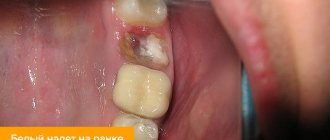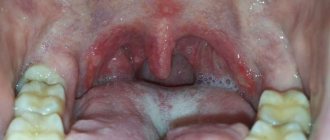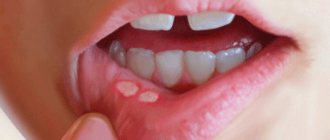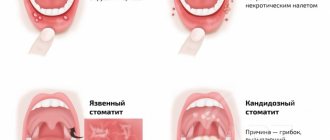Aphthous stomatitis is an acute inflammation of the oral mucosa with the formation of painful erosions (aphthous). Small round ulcers form on the inside of the lips, cheeks, tongue, tonsils, cause constant pain and affect overall well-being. Stomatitis is caused by a viral or bacterial infection, microtrauma of the mouth. But most often the disease develops against the background of stress or a decrease in the body’s defenses.
What is aphthous stomatitis
The exact mechanisms of development of aphthous stomatitis are still unknown.
It is generally accepted that with aphthous stomatitis, the infection enters the oral cavity, but does not cause a protective reaction in the body's immune cells. They simply do not recognize the pathogen. The infection changes the composition of saliva, this causes the activity of lymphocytes and the immune system attacks areas of the oral mucosa as a foreign chemical agent.
As a result of this confrontation, erosions form on the mucous membrane.
Aphthae have a round or oblong shape with a diameter of up to 5 mm. Outwardly, they resemble ulcers, covered with a white or gray coating and outlined with a red rim. On the mucous membrane, aphthae are located in groups or separately.
If more than three canker sores have formed in the mouth, this is a severe form of stomatitis. Despite their small size, the ulcers are painful and interfere with eating and talking. With stomatitis, the temperature may rise and weakness may appear.
If a person's immune system is weak, it will continue to interpret the presence of foreign chemicals in the mouth as a danger and canker sores will become chronic. Therefore, it is important to start treatment of aphthous stomatitis on time and carry it out under the supervision of a doctor.
What is brilliant green
Brilliant green - this is the inscription on the bottle of the well-known antiseptic liquid, which is popularly simply called “green stuff”.
This drug has an interesting history - it was originally created as an ordinary household dye in 1879. Only a century later, the antiseptic potential of this substance was discovered completely by accident. Since then, in some countries they began to use such a liquid for external treatment, smearing it on injuries, for example, wounds and abrasions.
Zelenka is a solution of dye in ethyl alcohol, which is used for cauterization and disinfection of wounds and ulcers on the skin and mucous membranes. In Russia, it began to be used only in the twentieth century, and besides us, green diamond is used only in a few other countries. Although the familiar green stuff is included in the list of approved medications, medicine all over the world has excluded it from priority means in the treatment of wounds due to its low effectiveness and the presence of side effects.
However, brilliant green works when used correctly; it can be used to smear lesions with the following diseases: pyoderma, furunculosis, carbunculosis, blepharitis, gordeoluma (boils on the eyelids, stye), acne.
Since brilliant green practically does not cause allergic reactions, it is smeared on the umbilical cord of newborns and used to antisepticize postoperative scars. Zelenka is effective in destroying gram-positive bacteria, eliminates diphtheria bacillus, staphylococcus, and some types of fungus.
For these reasons, brilliant green for stomatitis is not used in all cases. We will look in more detail below at how this remedy works if you smear it on ulcers in the mouth.
Causes of aphthous stomatitis
Aphthous stomatitis can be an independent disease or develop as a result of complex causes. Among them:
- Using aggressive agents that dry out the oral cavity (for example, sodium lauryl sulfate) during daily oral hygiene. The mucous membrane becomes more vulnerable, especially to sour and pungent tastes, and ulcers easily form on it.
- Mechanical damage to the oral cavity. Accidental biting of the inner surface, scratches from fillings and dentures, sharp chips of a tooth, rough traumatic food violate the integrity of the mucous membrane, and the resulting ulcer can serve as the beginning of the disease.
- Nervous tension and stress.
- Unbalanced nutrition, diets, nutrient and mineral deficiencies. Particularly critical is the lack of iron, zinc, folic acid, selenium, and vitamins B and C.
- Allergy to food. Products with gluten (flour), apples, tomatoes, chocolate, seafood and some food additives are critical.
- Menstrual cycle in women. Codependency with aphthous stomatitis is observed in only 10–15% of cases.
- Genetic predisposition.
- Chronic blood diseases, gastrointestinal tract, immunodeficiencies.
- Long courses of taking nonsteroidal drugs, medications for arrhythmia and high blood pressure.
Why isn't brilliant green used in the West?
Zelenka has long been considered a domestic medicine, despite the fact that it was developed in London. This is due to the fact that Europeans and the British very quickly abandoned the use of coloring medical products. The mentality of residents of European countries does not accept therapy that somehow distinguishes a sick person from healthy ones.
It was thanks to this that the white domestic adhesive plaster in the West acquired a flesh color, and the brilliant green was replaced with colorless antiseptic solutions. Pharmacies and medical institutions do not sell brilliant green solution. It was abandoned even in laboratories and clinics, where it is necessary to process medical instruments, premises and the hands of personnel.
Is stomatitis contagious?
Canker sores can be contracted if the condition is caused by a virus, fungus, or infection. The pathogen is easily transmitted through shared objects and airborne droplets.
Children are especially susceptible to infectious stomatitis - due to their age, the mucous membranes of the oral cavity have not yet formed the required level of protection. Aphthous stomatitis is especially severe in infants, including those with damage to internal organs. Adults have a chance of getting sick only when they have microcracks or abrasions in the mouth.
Fungal stomatitis is transmitted through water, dishes, and food.
Stomatitis that develops as a result of vitamin deficiency, stress or mechanical trauma is not contagious.
The dangers of using brilliant green for stomatitis
Treatment of stomatitis is best carried out under the supervision of a physician, using medications prescribed by a specialist, both for oral administration and locally - for treating the affected mucous membrane.
The use of brilliant green for stomatitis is dangerous because it may be ineffective in cases where the disease is caused by a viral infection or is a consequence of tissue damage by gram-negative bacteria that are insensitive to this drug.
In fact, a person will simply waste time and instead of treating the disease, the infection will spread throughout the entire oral cavity. To prevent this from happening, it is important to consult your doctor initially.
In addition, the danger of using brilliant green solution in the treatment of stomatitis is that it can lead to severe chemical burns, since the base of the drug is pure medical alcohol. A burn can cause tissue necrosis, which will only worsen the situation.
Symptoms of the disease and its complications
Aphthous stomatitis does not begin with the formation of ulcers. The stages of the disease are:
- The lymph nodes become inflamed, the temperature rises and general weakness occurs.
- Small blisters form in the mouth, which spontaneously open and turn into aphthae.
- Salivation increases.
- At first, it is unpleasant for the patient to eat food with a pronounced taste, and then chewing any food causes pain.
- With a persistent form of aphthous stomatitis, the lymph nodes become inflamed and become painful on palpation.
- The mucous membranes of the mouth are loose and inflamed.
- A white coating appears on the tongue.
- At the final stage of the disease, aphthae scar, and soreness in the mouth disappears.
If the patient has not received adequate treatment, aphthous stomatitis becomes chronic. Wherein:
- The mucous membranes swell and turn pale.
- Aphthae grow and cover the inner surface of the cheeks, palate and back of the tongue. In advanced forms, the ulcers rise above the surface of the oral mucosa.
- Without receiving proper treatment, the growth of ulcers resumes every two weeks. The wounds bleed and penetrate deeper into the tissues of the mouth.
- When healing, erosions leave deep scars.
Composition of Zelenka and pharmacological action
The brilliant green is based on a solution of brilliant green. This is an antiseptic substance that was developed by a British scientist. In his attempts to discover a cure for malaria, he was able to create substances with bright colors. At first these were purple and lilac solutions that were not removed from fabrics and other surfaces.
Doctors began to use this feature of giving color to substances to color reagents and microorganisms during microscopic studies. During this application, it turned out that microbes die under the influence of a brilliant green solution. This is how the antiseptic properties of brilliant green were discovered.
Classification and forms of the disease
According to the nature of the disease, stomatitis can be:
- Spicy . The appearance of painful ulcers in the mouth is accompanied by fever. The disease lasts 2–3 weeks;
- Chronic . The disease progresses in waves, with periods of long lulls and rare exacerbations. Lasts up to 2–3 years.
According to the type of pathogen, stomatitis is:
- Viral . Its causative agent is the herpes virus. It causes bubbles of clear liquid to appear. After the bubbles burst, aphthae remain in their place.
- Radial . If the mucous membrane is irradiated by ionizing radiation, compactions and erosions may occur.
- Fungal . Occurs when immunity decreases or a shock dose of antibiotics. A powdery coating forms on the seals of the mucous membrane, and when you try to remove it, the aphthae is exposed.
- Bacterial . Caused by streptococci and staphylococci. The whole process goes quickly - ulcers are actively formed, aphthae quickly stop hurting and heal.
- Chemical . This is the result of burns to the mouth from acids or alkalis. In this case, deep ulcers are formed and the tissue is deformed.
Depending on the type of pathogen, several forms of acute stomatitis are distinguished:
- Fibrinous. In the initial stage, rashes appear no more than 1–3 times a year during exacerbations of systemic diseases or microtraumas of the mouth. Small blisters covered with fibrous plaque are located on the inner surface of the lips, tongue, and cheeks. They scar after 1–2 weeks. If the cause of the disease is not treated, aphthae form more and more often and cover large areas.
- Necrotic. Typical for patients suffering from severe chronic pathologies. In this case, aphthae become a consequence of the death of the epithelium. In the initial stage, aphthae are painless, but then develop into ulcers that do not close within a period of several weeks to a month.
- Gradular . It develops when the salivary glands are damaged, and aphthae develop next to them. The ulcers are painful and take 1 to 3 weeks to heal, after which the ulcers reopen.
- Scarring. Aphthae cover the mucous membrane of the mouth near the salivary glands, pharynx and palate. At first they are small in size, but quickly unite into deep painful ulcers with a diameter of up to 1 centimeter. They heal slowly (up to 3 months) and form scars.
- Deforming. The most severe form of aphthous dermatitis. Aphthae grow deeply into the mucous membrane and, when healing, form rough scars that deform the oral cavity. Deforming stomatitis is the most difficult to treat; recovery will take at least 2 months.
- Herpetic . Consequence of infection by the herpes virus. Up to 30 small ulcers simultaneously form on the mucous membrane, the tissues become inflamed and turn bright red. It is more common in infants who become infected with the virus in utero or during childbirth.
- Recurrent . Aphthae do not heal for a long time, merge with each other and form a large painful ulcer. The lesions become covered with a white coating, make it difficult to eat, and the person suffers from pain and burning. This form of stomatitis occurs only in adults.
In children, 2 forms are most often observed:
- Spicy . Children under 3 years old are ill, usually against the background of other infectious diseases - whooping cough, diphtheria, measles. In acute stomatitis, a lot of saliva is released, the smell from the mouth is unpleasant, putrefactive.
- Mixed. They appear in children over 4 years of age and cause frequent relapses. In this case, the disease affects an increasingly larger area each time.
Diagnosis of the disease and its differences from other pathologies
The doctor receives the first data after examining the patient’s mouth. Next, the doctor collects an anamnesis of the disease and the patient must answer when the first symptoms appeared, how quickly the disease developed, whether there were injuries (including burns) to the oral cavity, allergies to foods and medications, whether close relatives suffered from stomatitis.
To identify the causative agent of the disease, you will need to take a smear on the flora and exclude manifestations of herpes and candidiasis. For this purpose, laboratory tests are used - bacterial culture and PCR smear.
For persistent stomatitis, you should check your blood glucose level.
Who is contraindicated for stomatitis?
Zelenka, like many other medications, has contraindications. It should not be applied to ulcers if certain diseases and conditions are diagnosed:
- Zelenka is contraindicated for young children, especially under the age of 1 year.
- The use of the solution during pregnancy and breastfeeding is not recommended.
- Zelenka is dangerous for people who have an individual intolerance to this solution.
In all other cases, smearing ulcers with brilliant green is allowed, unless there are other recommendations from the attending physician.
The use of brilliant green in the treatment of stomatitis in adults and children is not the best therapeutic tactic, however, in some cases it can serve as an antiseptic. If the use of brilliant green does not bring improvement, you should stop using it. In addition, if stomatitis is suspected, it is necessary to visit a doctor as soon as possible for an accurate diagnosis, determining the causes of the disease and prescribing effective treatment.










